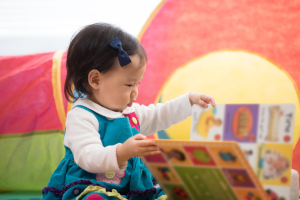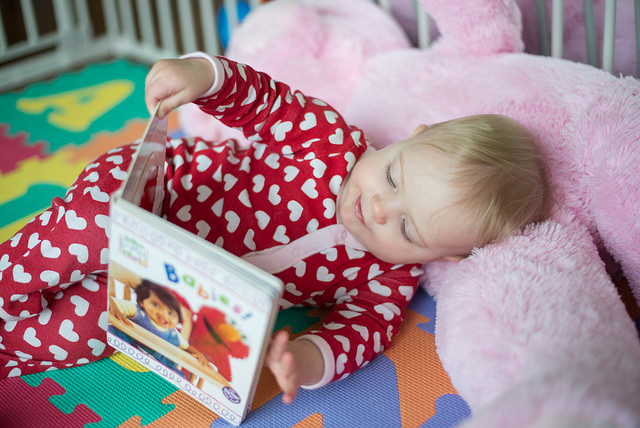Reading to your baby is oh-so-important. Here are 7 quick tips to make story time a favorite part of the day.
There’s nothing quite like cuddling up with your baby for storytime. It’s fun and ripe with educational benefits that range from building language skills to nurturing emotional development. The American Academy of Pediatrics guidelines recommend reading with baby from day one. But a newborn’s lack of motor skills and less-than-refined eyesight means story time is not as simple as plopping her into your lap and cracking open a book. A little creative thinking is all you need to put your newborn on a literary path of success.

Think Outside the Lap
A newborn doesn’t have the motor skills to sit in your lap and hold her head up like an older baby or toddler. Read to baby from your nursery’s glider while she rests in her crib or bassinet. Or if you want to snuggle during story time, recline in your favorite chair or couch and lay baby on your chest. It’s all about being comfortable with baby and your book.
Get Down To Baby’s Level
Do the screams of your newborn during tummy time have you dreading this daily ritual? Consider it an opportunity to get down next to baby and read to her. Best case scenario, your voice and the pictures will soothe and distract her into a calm state. Even if she isn’t quiet, at least it’ll give you something to do other than fretting over her distress. This also works with both of you on your backs, and as an added bonus, it may build up your arm strength.
Build It Into the Routine
Your newborn is fresh and clean from the bath and ready for snuggle time. Or maybe she has just finished eating and is content and sleepy. These are the perfect times to establish a routine for storytime. Take an activity that you do with baby every day and make reading a part of it.

Focus On The Pictures
Some of the best books for a newborn’s developing eyes have bold images with very little text (or none at all). Look for board books with bright contrasting colors, simple patterns, or black and white pictures. Satisfy your newborn’s fascination with staring at other babies by sharing books that have real photographs of babies in them, like the Look Baby! books by Margaret Miller.
Add In Texture
Provide books that allow your newborn to use more than one sense. Cloth and plastic books are durable and washable, allowing baby to smash, squish, and even gum them. Introduce baby to new textures and sensations with one of the many touch-and-feel books available, like the Usborne Touchy-Feely books in the That’s Not My series. Keep in mind you’ll have to help your newborn reach out and touch these books to fully experience them.
Don’t Forget About the Words
Picture books with rhymes, fun language, and a poetic rhythm build a foundation for language and reading skills. The silly nonsensical words of Dr. Seuss’ books will expose baby to the different sounds of letters and words. Plus they’re fun to read! Don’t be afraid to ham it up, using exaggerated voices and gestures. The more fun you have reading to your newborn, the more fun she will have.

Make It About You
Have you gotten to the point where you just can’t stomach reading another children’s book and you want to feel like an actual adult? Go ahead and pick up that mystery you’ve been neglecting or the textbook for that night class you’re taking and read it aloud to baby. Your newborn doesn’t need to understand the words to reap the benefits of storytime.











